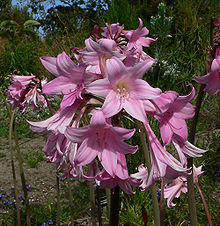
Back Amaryllidaceae Afrikaans نرجسية (نبات) Arabic الفصيلة النرجسيه ARZ Amaryllidaceae AST Nərgizçiçəyikimilər Azerbaijani Амарылісавыя Byelorussian Амарылісавыя BE-X-OLD Кокичеви Bulgarian Amaryllidaceae BS Amaril·lidàcies Catalan
| Amaryllidaceae | |
|---|---|

| |
| Amaryllis belladonna | |
| Scientific classification | |
| Kingdom: | Plantae |
| Clade: | Tracheophytes |
| Clade: | Angiosperms |
| Clade: | Monocots |
| Order: | Asparagales |
| Family: | Amaryllidaceae J.St.-Hil. nom. cons.[1][2] |
| Type genus | |
| Amaryllis | |
| Subfamilies | |
| Synonyms | |
|
Alliaceae Borkh. | |
The Amaryllidaceae are a family of herbaceous, mainly perennial and bulbous (rarely rhizomatous) flowering plants in the monocot order Asparagales. The family takes its name from the genus Amaryllis and is commonly known as the amaryllis family. The leaves are usually linear, and the flowers are usually bisexual and symmetrical, arranged in umbels on the stem. The petals and sepals are undifferentiated as tepals, which may be fused at the base into a floral tube. Some also display a corona. Allyl sulfide compounds produce the characteristic odour of the onion subfamily (Allioideae).
The family, which was originally created in 1805, now contains about 1600 species, divided into about 70–75 genera,[3][4] 17 tribes and three subfamilies, the Agapanthoideae (Agapanthus), Allioideae (onions, garlic and chives) and Amaryllidoideae (amaryllis, daffodils, snowdrops). Over time, it has seen much reorganisation and at various times was combined with the related Liliaceae. Since 2009, a very broad view has prevailed based on phylogenetics, and including a number of other former families.
The family is found in tropical to subtropical areas of the world and includes many ornamental garden plants and vegetables.
- ^ Jaume Saint-Hilaire 1805, Amaryllidées vol. 1. pp. 134–142.
- ^ APG 2009.
- ^ "Amaryllidaceae J.St.-Hil". Plants of the World Online. Royal Botanic Gardens, Kew. Retrieved 3 November 2021.
- ^ Christenhusz, M. J. M.; Byng, J. W. (2016). "The number of known plants species in the world and its annual increase". Phytotaxa. 261 (3): 201–217. doi:10.11646/phytotaxa.261.3.1.